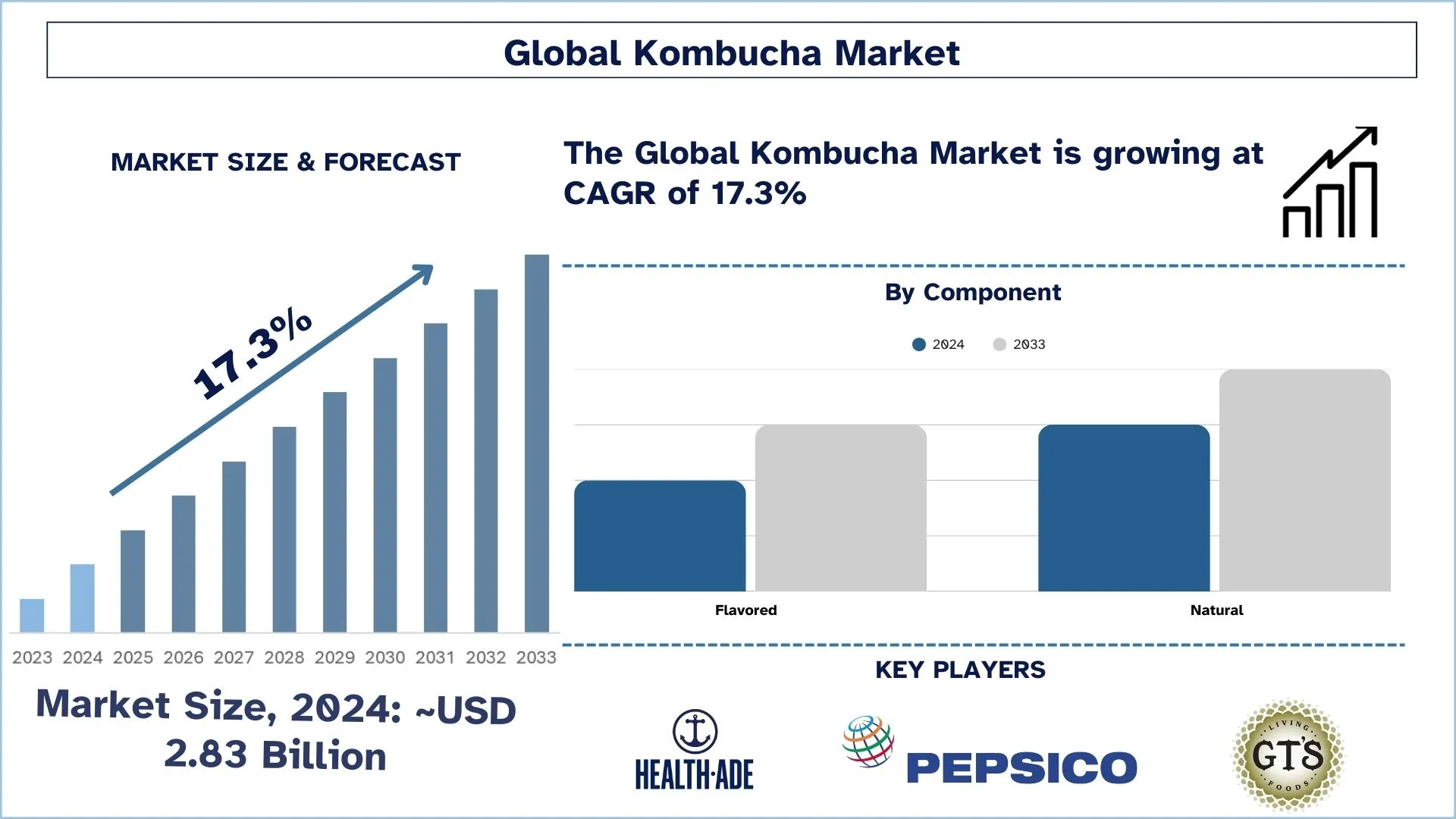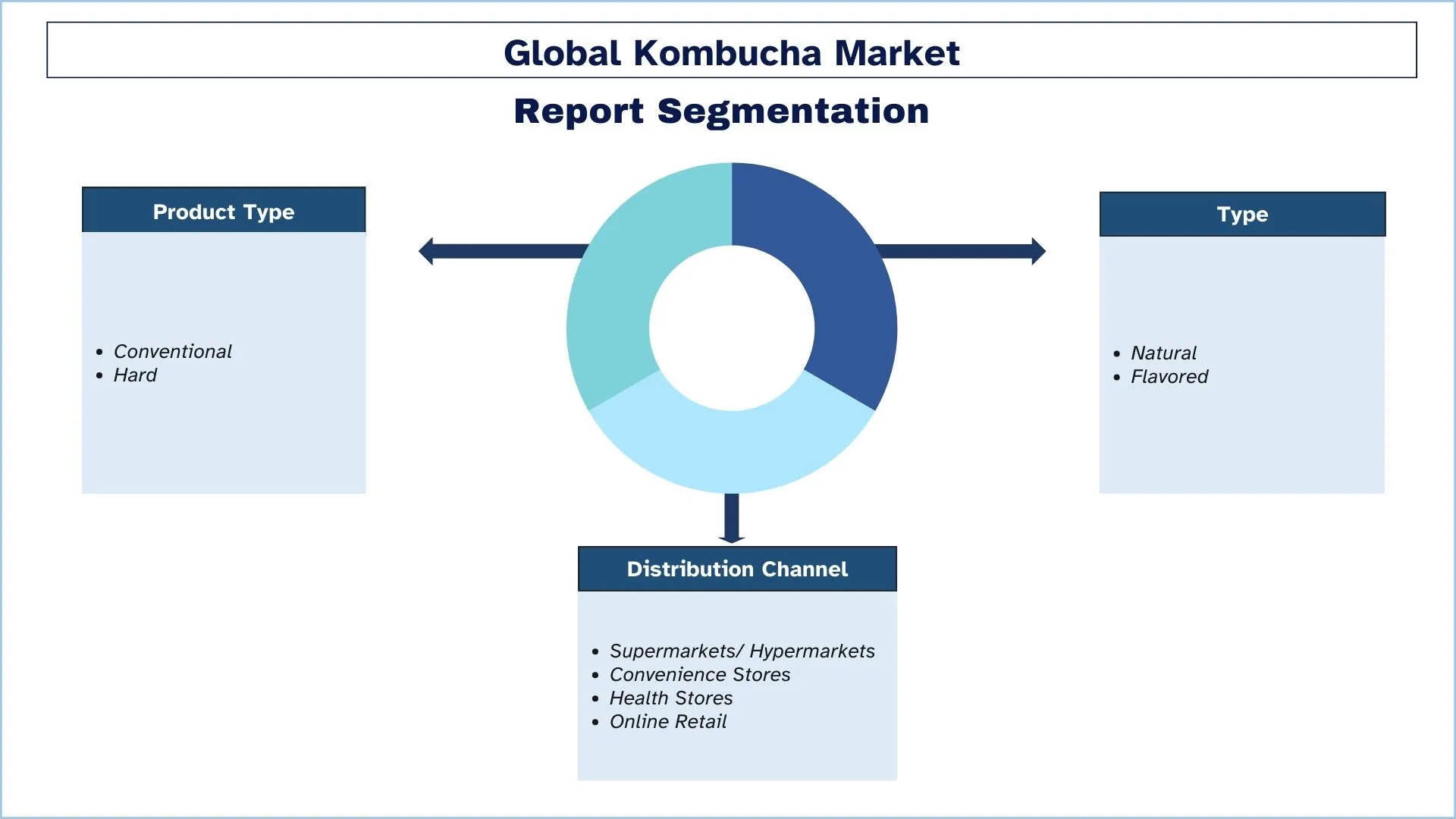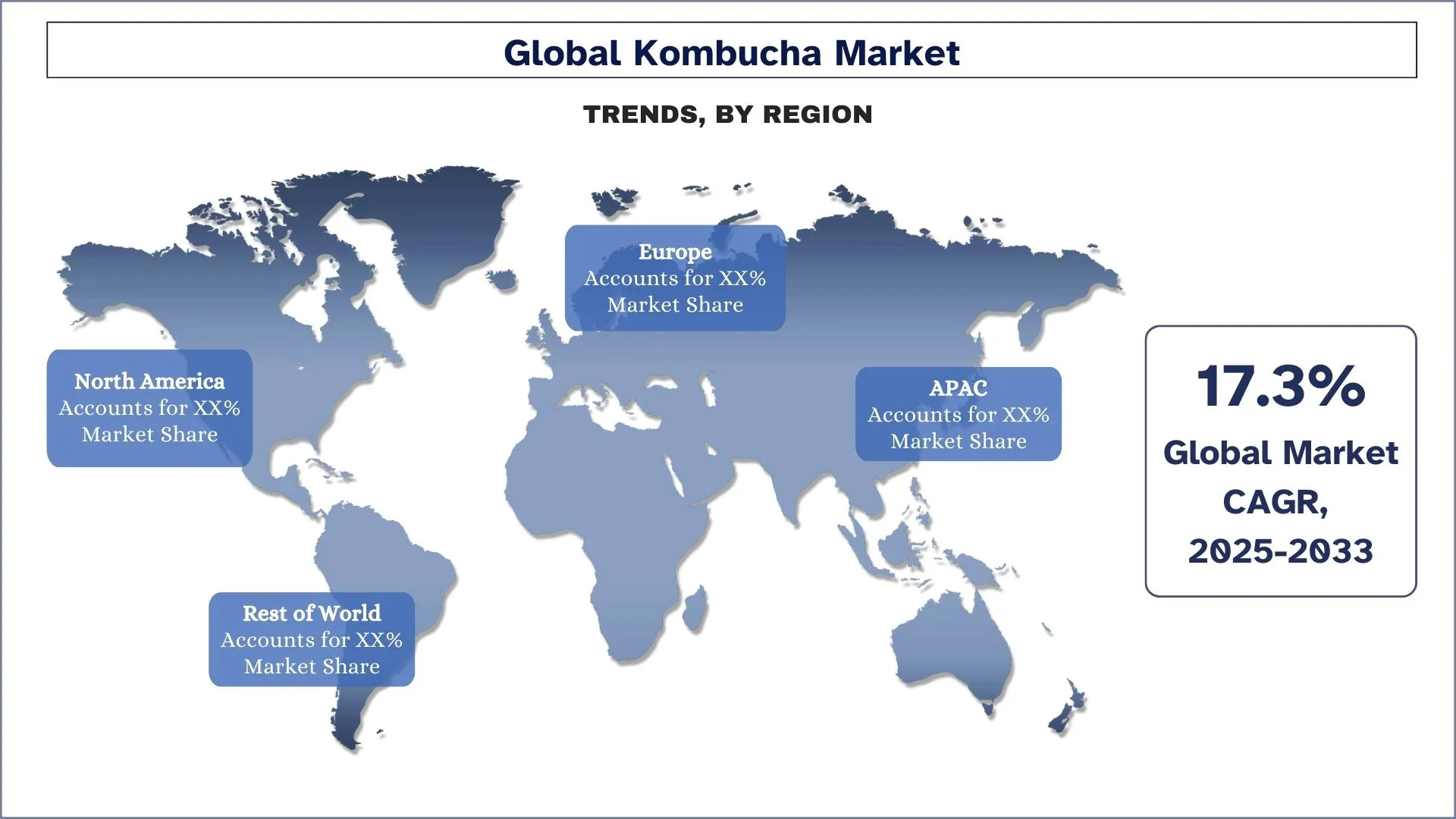- Home
- About Us
- Industry
- Services
- Reading
- Contact Us
Kombucha Market: Current Analysis and Forecast (2025-2033)
Emphasis on Product Type (Conventional and Hard); Type (Natural and Flavored); Distribution Channel (Supermarkets/ Hypermarkets, Convenience Stores, Health Stores, and Online Retail); and Region/Country

Kombucha Market Size & Forecast
The kombucha market was valued at approximately USD 2.83 billion in 2024 and is expected to grow at a substantial CAGR of around 17.3% during the forecast period (2025-2033), owing to increasing consumer preference for functional drinks with added health benefits contributing to kombucha's popularity.
Kombucha Market Analysis
The kombucha market has been growing steadily across the world due to increased consumer awareness of the health benefits of functional beverages that support the gut.” Kombucha is a newly famous fermentation tea containing probiotics and is a healthy and good substitute for sugar-filled soft drinks and energy drinks. It’s aided by new, exciting flavors, organic products, and wider and varied distribution outlets, coupled with the public’s growing understanding of the health benefits of the products. As the millennial generation and other health-conscious consumers keep on demanding more and more kombucha, the drink has found its way into both mass and specialty markets.
Kombucha Market Trends
This section discusses the key market trends influencing the various segments of the Kombucha Market as identified by our research experts.
Surge in Generative AI Applications
One of the greatest global AI trends that can be seen currently is the rapidly growing usage of generative AI, including large language models, and AI-driven content creation. These technologies are transforming industries in the sense that they are automating customer support, writing articles, and even computer programming. The application of generative AI is becoming more widespread and making organizations more productive, to improve the quality of services provided. It has been rewriting the way people work as well as responding to the need for innovation across the spectrum.
Kombucha Industry Segmentation
This section provides an analysis of the key trends in each segment of the global Kombucha report, along with forecasts at the global, regional, and country levels for 2025-2033.
The Conventional Segment Holds the Largest Share of the Kombucha Market.
Based on product type, the market is bifurcated into conventional and hard. The conventional category is expected to have the largest market share of the kombucha market. Conventional kombucha is made from the normal brewing processes and is cheaper than the premium or organic types, and hence targets price-sensitive consumers in society. This segment will enable the company to reach consumers who have not been concerned with the organic certification but have an interest in the benefits of the kombucha.
The Natural Kombucha Market is Expected to Witness a Higher CAGR than the Kombucha Market.
Based on the type, the market is bifurcated into natural and flavored. Among these, the natural kombucha market is the largest contributor to the kombucha industry. The natural category targets consumers who want products that contain no artificial ingredients or preservatives. Regular kombucha is often packaged and presented as a healthier and purer product, which certainly appeals to the customer segment that pays much attention to the quality of what they consume.

North America has a significant share of the market in 2024.
North America's kombucha market is growing significantly because of increased consumer awareness of health benefits, availability of the product, and the American consumer’s preference for functional and natural foods. The United States is the most developed market, with new brands of kombucha continually spicing up the market with new flavors and organic products to capture the market of different consumers. Canada is an important part of the region’s growth, and kombucha is a product that is increasingly finding its way into the natural food sections of grocery stores and becoming more and more popular among consumers who are focused on their health. As the distribution in conventional retail outlets continues to grow, North America has been identified as the most profitable and most competitive market for kombucha.
U.S. Dominates the North American Kombucha Market
The U.S. AI market is growing every year, provided the government promotes investment for R&D, and widely applied fields include health care, finance, manufacturing, and so on. The country is at the forefront of AI creation by benefiting from the proper development of IT infrastructure and universities. The exciting opportunities in the application of AI are still out there, but issues such as data privacy and regulation do hold back the progress of this technology.

Kombucha Industry Competitive Landscape
The Kombucha market is competitive, with several global and international players. The key players are adopting different growth strategies to enhance their market presence, such as partnerships, agreements, collaborations, new product launches, geographical expansions, and mergers and acquisitions.
Top Kombucha Companies
Some of the major players operating in the market are PepsiCo, Inc.; GT's Living Foods; Health-Ade LLC; The Hain Celestial Group, Inc.; SYSTM Foods Inc. (Humm Kombucha); Wonder Drink; NessAlla Kombucha; Cruz Group, Inc. (Vigo Kombucha); MOMO Kombucha; Nørrebro (Læsk).
Recent Developments in the Kombucha Market
In January 2024, Lo Bros introduced a limited-edition Purple Grape flavored kombucha, which aims to evoke nostalgia by offering a familiar taste from childhood in a modern and healthier format. This new beverage has an organic infusion that enhances the classic purple grape flavor with a refreshing fizz, making it not only enjoyable but also beneficial for gut health.
In November 2023, Momo Kombucha and Orbit Beers collaborated to create an alcohol-free hopped kombucha. This innovative beverage combines the probiotic benefits of kombucha with the complex flavors of hops, typically found in craft beers. The collaboration was aimed at offering a unique and healthy alternative to traditional alcoholic drinks, catering to the growing demand for non-alcoholic options. This product is part of a broader trend toward health-conscious consumption, highlighting the evolving preferences in the beverage market
Kombucha Market Report Coverage
Details | |
Base year | 2024 |
Forecast period | 2025-2033 |
Growth momentum | Accelerate at a CAGR of 17.3% |
Market size 2024 | USD 2.83 Billion |
Regional analysis | North America, Europe, Asia-Pacific, Rest of the World |
Major contributing region | North America is expected to grow at the highest CAGR during the forecasted period. |
Key countries covered | U.S., Canada, Germany, France, UK, Spain, Italy, China, Japan, and India |
PepsiCo, Inc.; GT's Living Foods; Health-Ade LLC; The Hain Celestial Group, Inc.; SYSTM Foods Inc. (Humm Kombucha); Wonder Drink; NessAlla Kombucha; Cruz Group, Inc. (Vigo Kombucha); MOMO Kombucha; Nørrebro (Læsk) | |
Report Scope | Market Trends, Drivers, and Restraints; Revenue Estimation and Forecast; Segmentation Analysis; Demand and Supply Side Analysis; Competitive Landscape; Company Profiling |
Segments Covered | By Product Type; By Type; By Distribution Channel; By Region/Country |
Reasons to Buy the Kombucha Market Report:
The study includes market sizing and forecasting analysis validated by authenticated key industry experts.
The report presents a quick review of overall industry performance at a glance.
The report covers an in-depth analysis of prominent industry peers with a primary focus on key business financials, product portfolios, expansion strategies, and recent developments.
Detailed examination of drivers, restraints, key trends, and opportunities prevailing in the industry.
The study comprehensively covers the market across different segments.
Deep dive regional-level analysis of the industry.
Customization Options:
The global kombucha market can be customized further as per the requirements or any other market segment. Besides this, UnivDatos understands that you may have your own business needs; hence, feel free to contact us to get a report that completely suits your requirements.
Table of Content
Research Methodology for Kombucha Market Analysis (2023-2033)
We analyzed the historical market, estimated the current market, and forecasted the future market of the global Kombucha Market to assess its application in major regions worldwide. We conducted exhaustive secondary research to gather historical market data and estimate the current market size. To validate these insights, we carefully reviewed numerous findings and assumptions. Additionally, we conducted in-depth primary interviews with industry experts across the Kombucha value chain. After validating market figures through these interviews, we used top-down and bottom-up approaches to forecast the overall market size. We then employed market breakdown and data triangulation methods to estimate and analyze the market size of industry segments and sub-segments.
Market Engineering
We employed data triangulation techniques to finalize the overall market estimation and derive precise statistical numbers for each segment and sub-segment of the global Kombucha Market. We split the data into several segments and sub-segments by analyzing various parameters and trends, including product type, type, distribution channel, and regions within the global Kombucha Market.
The main objective of the Global Kombucha Market Study is to
The study identifies current and future trends in the global Kombucha Market, providing strategic insights for investors. It highlights regional market attractiveness, enabling industry participants to tap into untapped markets and gain a first-mover advantage. Other quantitative goals of the studies include:
Market Size Analysis: Assess the current and forecast market size of the global Kombucha Market and its segments in terms of value (USD).
Kombucha Market Segmentation: The study segments the market by product type, type, distribution channel, and region.
Regulatory Framework & Value Chain Analysis: Examine the regulatory framework, value chain, customer behavior, and competitive landscape of the Kombucha industry.
Regional Analysis: Conduct a detailed regional analysis for key areas such as Asia Pacific, Europe, North America, and the Rest of the World.
Company Profiles & Growth Strategies: Company profiles of the Kombucha Market and the growth strategies adopted by the market leaders to sustain the fast-growing market.
Frequently Asked Questions FAQs
Q1: What is the Kombucha market's current size and growth potential?
As of 2024, the global Kombucha market is valued at approximately USD 2.83 billion and is expected to grow at a CAGR of 17.3% through 2033.
Q2: What are the driving factors for the growth of the Kombucha market?
The growth of the kombucha market is driven by rising consumer demand for health-conscious drinks, with kombucha offering gut health benefits. There’s also a growing preference for customizable products, sustainability in sourcing and packaging, and the rise of e-commerce for easier access to consumers
Q3: Which market has the largest share of the Kombucha market by product type
The conventional category currently holds the largest market share in the product type segment.
Q4: What are the major trends in the Kombucha market?
Key trends include rising demand for health-focused beverages, with kombucha’s gut-health benefits gaining popularity. Customization of flavors and functional ingredients is on the rise, and sustainability is increasingly important for both consumers and brands. E-commerce and direct-to-consumer models are expanding market access.
Q5: Which region will dominate the Kombucha market?
North America leads the global Kombucha market.
Q6: What are the biggest challenges in the Kombucha market?
Challenges include intense competition, making differentiation essential. Ensuring scalable production while maintaining quality is difficult, and regulatory compliance around alcohol content and health claims is crucial. Additionally, supply chain risks like fluctuating raw material costs can affect profitability.
Q7: Who are the Top players in the global Kombucha market?
The leading companies driving innovation in Kombucha include:
GT's Living Foods
Health-Ade LLC
The Hain Celestial Group, Inc.
SYSTM Foods Inc. (Humm Kombucha)
Wonder Drink
NessAlla Kombucha
Cruz Group, Inc. (Vigo Kombucha)
MOMO Kombucha
Nørrebro (Læsk)
Q8: What technologies are shaping the future of kombucha production?
Emerging technologies like automated fermentation and precision fermentation improve production efficiency. Smart packaging and AI-driven analytics help businesses optimize quality, predict trends, and enhance consumer engagement.
Q9: What regulatory factors should businesses consider when expanding into new kombucha markets?
Ans: Businesses should be aware of local alcohol regulations, labeling requirements, and import/export laws. Compliance with health claims and ingredient standards is essential for smooth market entry and avoiding legal issues.
Related Reports
Customers who bought this item also bought










